Well - Halloween is fast approaching! As I was thinking about trick-or-treating, it made me think about the tricks that our body can play on us. So, for the month of October, I'm going to be covering the different ways that our body can trick us.
This week we're going to be talking about trigger points. You may have never heard of trigger points before, but you probably have felt them! When our muscles contract, the entire muscle does not contract all at once. If you start with your elbow straight and slowly bend your elbow, your bicep is one of the main muscles that does this action.
However, when you start to bend your elbow, the entire bicep muscle does not contract all at once. At first, the part of the bicep that's closest to your elbow is the only part that contracts, then slowly the middle portion of the bicep will contract, and then when your fist is up next to your shoulder, the upper portion of the bicep will be contracting.
This is how our muscles are supposed to work: Different sections contract depending on what our body is doing at that time - and then they relax when we stop moving that body part. At least that's how it's supposed to work. Sometimes little sections of our muscles will stay contracted even after we've stopped using that muscle. This tiny little section of muscle that remains in a contracted state is usually kind of hard to the touch. If you've ever felt a knot in a muscle, you're feeling a trigger point.
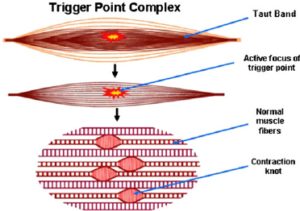
In this blog, I'm going to mention the different types of trigger points, trigger point pain referrals, and the three most common trigger point referrals I see in my patients that try to trick us about where the pain actually is.
There are two types of trigger points:
1) Active trigger points
2) Latent trigger points
If you're walking around and you feel a painful area in a muscle, that is an active trigger point. That means that it's painful at rest. But if you've ever had a massage, and when the massage therapist starts pressing on an area, you find that it's super tender and very painful, but it wasn't painful until they touched it, that is what's called a latent trigger point.
Trigger points are known to produce what is called referred pain. If you have ever heard of the symptoms of a heart attack, specifically the pain down the left arm, this is another example of referred pain. Referred pain is when one specific structure is irritated, but we actually feel the pain in other areas.
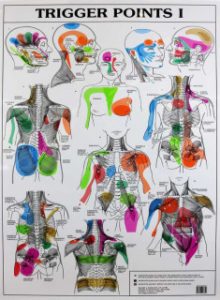
This can be extremely confusing, but it's very important to know if your pain is referred or not. Imagine if you went to the hospital with chest pain and left arm pain, and the nurses just started treating your left arm. You probably wouldn't have a very good outcome.
This is why it's important that your doctor is familiar with the concept of referred pain.
Otherwise valuable treatment time may be wasted on areas that are not actually irritated, but are just the location of referred pain.
The woman who first discovered trigger points created maps of trigger point referral patterns. These maps showed the areas where referred pain is felt for all the different trigger points in all of the muscles of the body.
The three most common trigger point referrals that I see in my practice are:
The gluteus medius muscles are located on the side of both hips. Trigger points in these muscles can send pain down the side and back of the thigh all the way to the back of the knee. Some doctors have called these trigger point referrals pseudo sciatica. Many people with trigger points in these muscles will actually think that they're having sciatica pain/issues, but really, it's just a trigger point.

Above you will see the trigger point referral map for the gluteus medius. It can cause pain around the low back or SI joint and all the way down the thigh to the knee. If you are having pain in these areas, I recommend you get assessed by a doctor who's familiar with trigger points.
__________________________
The infraspinatus muscle is on the back of the shoulder. However, the trigger point referral actually wraps around to the front of the shoulder. Sadly, I have seen patients who had surgery on the front of their shoulder - and their pain didn't change at all. It was only after treatment to the infraspinatus on the back of the shoulder that their pain went away.
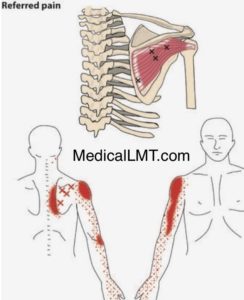
Above you'll see the trigger point referral map for the infraspinatus. It can cause pain along the inner shoulder blade area, the front of the shoulder, and down the bicep. If you've had pain in these areas and maybe even have had some treatment with no help, make sure to see a doctor who's familiar with trigger points.
_________________________
And finally, there is the thoracic erector spinae. The erector spinae muscles are the muscles that run up the spine very close to the bones of the spine. These are the muscles that help us stand up tall. In the thoracic region or mid-back, trigger points in these muscles can actually refer pain to the low back and tailbone. I will often see patients who complain of low back pain and have had lots of adjustments to the low back and pelvis with no improvement. Once we treat the erector spinae, their pain goes away.
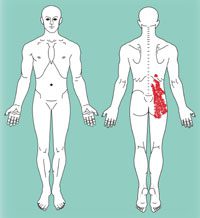
Above, you can see the trigger point referral map for the thoracic erector spinae. Interestingly, you can see that the pain referral map is almost completely in the low back. Meaning: You might not have any pain in your mid back, but that's actually where your problem is. These muscles can refer pain down to your low back tailbone and even the back of your hip. If this is a problem area for you - again - please make sure to see a doctor who's familiar with trigger points.
So there you have it, our body can really try to throw us for a loop. This is why it's always good, when you're in pain, to get a proper evaluation by a doctor who will look at all areas of the body and not just where you're hurting. This is something we do with every patient here at Movement Laboratory. If you're hurting and you suspect that you might have some referred pain going on or any other type of pain, give us a call at 918-300-4084 and we'll help you get out of pain fast!
Tune in next week when I'll discuss how some of our internal organs can cause pain all across our body!


Last week I went over the main things you need to know about bunions and how they affect you. This week we're going to cover what you can do to stop a bunion's progression or even reverse it!
So what does a strong foot look like? Well it's not what you think. We don't really need our feet to be especially strong - what we need is just for them to be active at the right times. Many people who have flat feet or bunions don't actually have weak foot muscles. It's more likely that they have weak hip and ankle muscles which then don't allow the foot muscles to activate like they should.
In order to have good strong feet, we have to be strong in other areas of the body as well. In this blog, I'm going to cover how to strengthen the feet, the ankles, and the hips. If you are strong in these three areas, that will stop the progression of bunions and sometimes even reverse them.
In order to strengthen the feet, we must first understand a little bit about how the foot works. The foot is constructed like a tripod. The three points of the tripod are:
A strong foot will keep these three points in contact with the ground as often as possible.
Our foot goes through a lot of different movements as we walk, climb, run and jump. The foot is meant to pronate, supinate, and be neutral and all the points in between. The issues that we have that lead to bunions tend to make our feet hang out most of the time in pronation. So in order to strengthen the foot, we need to strengthen the muscles that keep us either in neutral or supination.
The best exercise to help this is what's called the short foot exercise. When our foot pronates, it lengthens and becomes more wide. The short foot exercise helps to activate the muscles that do the opposite action. The video below shows how to do the exercise. I recommend doing just this exercise alone for two weeks. Usually doing about two to three sets of 10 at a time.
Once you feel confident doing this exercise, then you can start applying it to a lot of different situations.
Doing this will help to transition the short foot from being just an exercise that you do to something you can be practicing during your day in real world situations.
The next exercise to help strengthen your feet is called the Vele lean. This exercise is shown in the video below and it really helps to strengthen the muscles of the feet. The short foot practice combined with this exercise is a great one-two punch for strong feet!
The foot does not work alone. The hips and the ankles help to support the motions of the foot. You could have the strongest feet in the world, but if you have weak hips and ankles, your foot will still get in bad positions.
The first exercise to help strengthen your ankles is called the tibialis posterior raise. The tibialis posterior muscle is one of the prime supinators of the foot. If your foot over-pronates or pronates too fast, it means the tibialis posterior is not strong enough to resist that. The exercise is shown in the video below. I recommend doing three sets of 10 everyday.
Once you've helped to strengthen your tibialis posterior, it's time to work on the stability of the ankle. In order to do that, you have to challenge the ankle in a lot of different directions. The best exercise to do this is called toe reaches. The video below demonstrates this exercise. The key here is that you'll be standing on one leg and reaching the other leg out in different directions. Be sure that you try to keep the foot that is on the ground as still as possible. It is going to move a little bit. but you don't want it to be wobbling all over the place.
As I mentioned above, if your hips are not strong, your feet are put at a disadvantage. Bunions develop from feet that remain in pronation for too long. The hip muscles that help to bring the foot out of pronation are the external rotators of the hip, primarily the gluteus, medius, maximus, and piriformis.
A great first exercise to start strengthening these muscles is called a glute bridge with abduction. The exercise is shown in the video below. I usually have people start with two sets of 10 and slowly work up to three sets of 12.
The next exercise is a great one because it can work on almost all of those muscles at once. It is called a lateral band walk. The video is shown below. Pay special attention to the placement of the band. By placing the band around the foot instead of the ankles like this exercise is normally done, it really works on those external rotators of the hip.
The final exercise really works on increasing control of the hip rotators. This exercise is called the hip airplane. When you start this exercise, you'll want to be close to a wall or a table that you can use for balance. After a couple of weeks doing the exercise, you need to start taking your hand off of whatever structure you're using for balance, and starting to try to balance on your own. Eventually you want to be able to do this exercise without using anything for balance.
Special/Simple Device to Help Stop/Correct Bunions
One final recommendation for stopping bunions or reversing them is actually a device to wear on your feet. This device is called correct toes. This simple silicone piece can be worn at all times even with socks and helps to maintain the placement of the toes which can help the deformation of the bunion. I recommend this for all bunions! They can be purchased here: https://www.correcttoes.com/shop/correct-toes/correct-toes.html?gclid=CjwKCAjwrqqSBhBbEiwAlQeqGrrmlzau3uTeVCbstoyU37gGT-kNmsutB_DoQC7TX_qjHgJxF1TZVhoCHBgQAvD_BwE
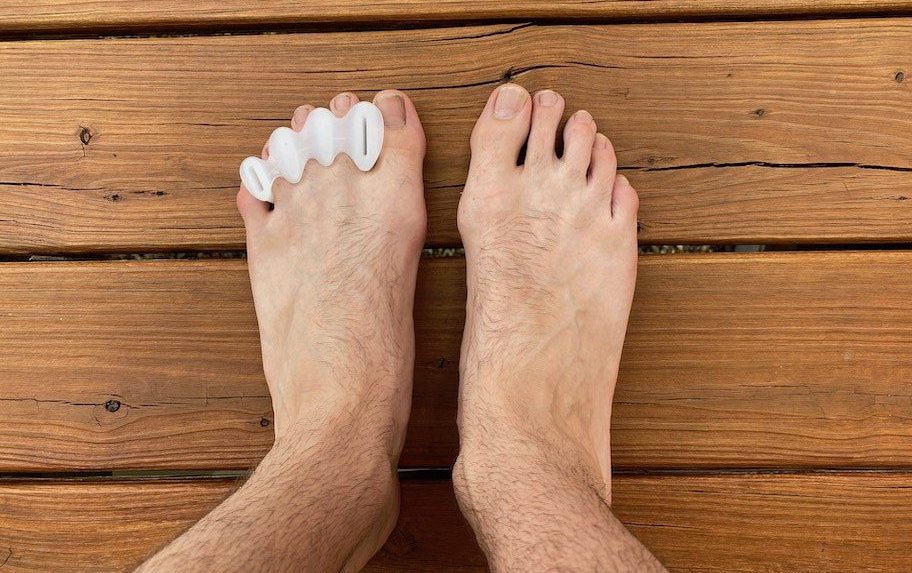
_________________________________________________
So there you have it. If you have a bunion, or if you're wanting to make sure you don't develop a bunion, this program includes my recommendations to make sure you know what to do to help ensure those results! And if you are looking for more help with your feet, give us a call at Movement Laboratory at 918-300-4084 and schedule an appointment today. We help get people moving better and out of pain fast!

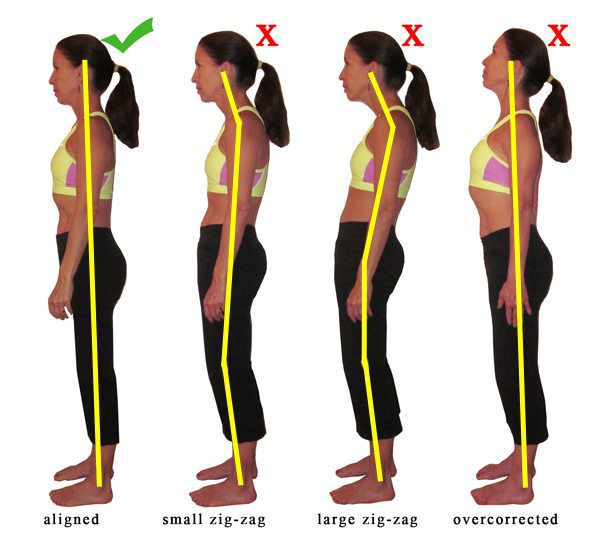
In today's world, we've pretty much learned that a functional core is vital to how our body performs. Many of the aches and pains that are common can be linked to an improperly functioning core. But what you may not know is that proper posture is a big player in how well your core functions.

Our core is functionally a cylinder. It has cylindrical walls and a roof and a floor. The walls of our core are the deep abdominal muscles in the front and sides and our spinal muscles in the back. The roof of the core is our diaphragm. The floor of the core is our pelvic floor muscles. The picture above illustrates this.
In order for the core to function properly, the walls, roof, and floor must all be aligned properly. The purpose of our core is to do two things: Our core attaches the top part of our body to the lower part, and it creates something called intra-abdominal pressure.

Intra-abdominal pressure is vital for proper core function. To picture what intra-abdominal pressure does, you need to imagine blowing up a balloon as much as you possibly can. Then imagine grabbing the balloon from the top and the bottom and trying to twist it or fold it over on itself.
If it's completely full of air, this will be difficult. But imagine you let a little bit of air out. Now it's easier to twist and bend that balloon.
The same concept applies to the core. When we have good intra-abdominal pressure, it helps to stabilize our spine and make it hard to bend and twist. This is important when we're lifting heavy things to help keep our spine safe. When we don't create intra-abdominal pressure well, our spine is vulnerable.
The roof has to be stacked directly over the floor. In regards to posture, this means that your diaphragm needs to be stacked directly over your pelvic floor. Your diaphragm is attached to your rib cage and your pelvic floor is attached to your pelvis. So, if your rib cage or pelvic posture is not ideal, then you are at a disadvantage for creating intra-abdominal pressure.

Many people have what's referred to as "open-scissors posture." This is when we have a little bit of an excessive arch in our low back that causes our rib cage to be tilted backwards and our pelvis to be tilted forwards. This creates really bad alignment and hinders the creation of intra-abdominal pressure. The picture above shows the open-scissors posture.
The video below shows the proper postural alignment and how to put your body in the best position to enable your core to function.
The exercises below are great to help make those postural corrections permanent. Remember to start these exercises with proper alignment.
It's easy to see how your Posture affects your Core!
And there you have it. Now you have some great tips for how to align your body to get better core function. If you are reading this blog because you have pain related to poor core function, we can help! Just come see us at Movement Laboratory to experience the MovLab Difference!
Using Chiropractic care and specific therapeutic exercises, we get people out of pain and back to what they love FAST! Call us at 918-300-4084 to schedule your appointment today.
